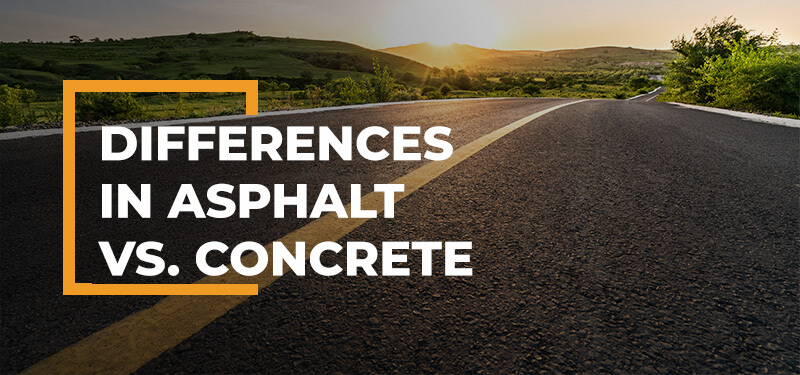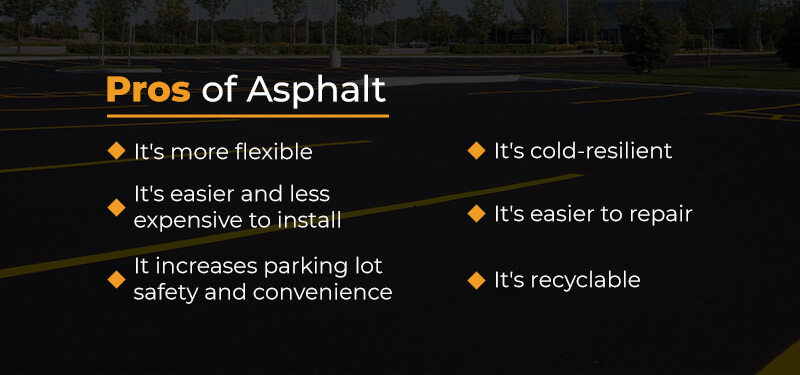On the surface, asphalt and concrete seem very similar. Besides the obvious difference that one is black and the other is usually a light gray, both create hard, paved surfaces known as “flatwork.” Each features an aggregate material, such as sand and gravel, and starts wet before hardening. Their main difference is in the binding agent that holds the aggregate together. Asphalt uses bitumen, which lends its rich, black color, while concrete features cement.
While asphalt and concrete seem so similar, some key differences can make one more favorable than the other, depending on the situation. While it’s common to see asphalt roads and parking lots alongside concrete sidewalks, that’s not a hard-and-fast rule. While an estimated 94% of the nation’s roadways are surfaced with asphalt, more than 57,000 miles of urban and rural roads are paved with concrete.
When it comes to parking lots and sidewalks, property managers have the flexibility to choose between asphalt or concrete for their paving needs. Exploring their differences, along with the benefits and disadvantages of each, will help you reach the right decision.
Pros of Concrete
Concrete is an increasingly popular choice for both parking lots and sidewalks. Some of the reasons many property managers prefer it include:
- It performs better in hot weather: There’s excellent news for properties in the Florida area — concrete does better in the heat. While hot temperatures can soften asphalt and make it oilier, concrete retains its rigid surface. Additionally, black pavement will be hotter in the sun. Because of this temperature difference, concrete expands less, lowering the risk of cracking. It’s also more comfortable to walk on and safer for pets.
- It requires less maintenance: In general, concrete requires less maintenance than asphalt. The main maintenance requirements are occasional joint sealing and annual cleaning. Installers place expansion joints to allow the surface to expand and contract. These joints control the way the material cracks, preventing more complicated repairs.
- It lasts longer: Typically, concrete will outlast asphalt by five to 10 years, with a general lifespan ranging from 20-40 years. Its lower maintenance needs and longevity make the material worth the investment in the long run.
- It’s more customizable: One reason we usually see concrete used for sidewalks is that the equipment required is a lot smaller than what’s used for asphalt installations. Therefore, it’s easier to use in narrow spaces like walkways and around curves and tight corners. Further, concrete offers additional design flexibility because it can be colored and stamped to look like brick, stone or tile.
Cons of Concrete
While we usually encourage concrete installations in Florida for their heat performance, they have some disadvantages. The downsides to concrete can include:
- It’s sensitive to the cold and salt: While not a significant concern down south, cold weather can be harsh to concrete. The extreme cold can make the surface uneven, creating a safety concern that needs prompt attention. Salt and ice melt can also corrode concrete.
- It’s more expensive up front: While you can enjoy added longevity and lower maintenance needs with concrete, it’s more costly to install. While you pay more at first, its lifetime cost is often lower than asphalt.
- It takes longer to cure: Another concern for a busy lot is that concrete can take up to a week to cure. This con means waiting longer before you can reopen your lot to vehicles and customers. However, with less maintenance down the road, you may win back that downtime later on.
- It requires water runoff management: Because concrete isn’t porous like asphalt, heavy rains present flooding concerns without proper drainage and runoff management. One solution here is to use pervious concrete, which allows rainwater to pass through and absorb into the soil below.
Pros of Asphalt
As a paving option for sidewalks and lots, asphalt is equally as widespread as concrete. Some reasons it’s the favored option in many situations include:
- It’s more flexible: One reason to consider using asphalt for walkways is that the spongier material is easier on people’s knees and feet. It absorbs impacts better than concrete, making it a more comfortable surface to walk or jog on.
- It’s easier and less expensive to install: Asphalt is simpler and quicker to install and takes less time to dry. In as little as two days, a parking lot or walkway can be laid, fully cured and ready to drive, walk and park on. The more straightforward installation process also makes it more affordable.
- It increases parking lot safety and convenience: Asphalt has a deep black color that creates high contrast against the pavement striping. The color makes stop lines, arrows and parking spot striping more visible, which can increase safety. Asphalt is also a smoother surface for drivers and absorbs more noise from traffic, enhancing the parking lot experience.
- It’s cold-resilient: While this is less of a concern in Florida, other parts of the country often prefer asphalt because it won’t deteriorate as quickly in freezing temperatures.
- It’s easier to repair: While asphalt requires more frequent repairs, they’re less involved than concrete repairs. At ToriTom Services, one of the ways we repair damaged asphalt is by saw cutting the damaged section and compacting new asphalt.
- It’s recyclable: One reason many facilities install asphalt is that when it’s time to repave, all the old asphalt can be sustainably made into new paving material. It’s infinitely recyclable, which is a big plus for properties that are certified in or want to meet green building standards.
Cons of Asphalt
While asphalt is a prevalent paving material, it comes with some downsides. Some of those drawbacks include:
- It requires more maintenance: Asphalt needs more care, such as saw cutting and refilling broken asphalt, overlaying potholes and regularly sealcoating the surface every three years. Extra preventive maintenance can create more disruptions in your lot and may cost more over the lifespan of the asphalt. The good news is that sealcoating asphalt and repairing damage while it’s small can prevent more significant issues or premature replacement.
- It’s more easily damaged: Gasoline leaks, which may happen every so often in a busy parking lot, can damage asphalt more easily than concrete. Extreme heat, which is a regular occurrence in southern climates, can cause asphalt to shrink and expand and forms an oily texture on the surface.
- It has a shorter lifespan: While quality, well-maintained asphalt can last 15-20 years, that’s a bit shorter than what you can expect with concrete.
Work With ToriTom Services for Commercial Concrete and Asphalt Installation and Repairs
When it comes to asphalt vs. concrete, both make excellent paving choices for various scenarios. For example, it’s common to use bitumen pavement for large parking lots for the ease of installation and added safety, and concrete for walkways since it’s easier to install in narrow lanes. However, we’re also seeing the opposite combination gain popularity. Concrete parking lots last longer and save on maintenance in the long run. Meanwhile, asphalt walkways provide a softer surface for walking and running.
Whatever paving option you choose, ToriTom Services can expertly get the job done. We’re proud to be a concrete and asphalt contractor you can trust. We hire top employees, prioritize management supervision, work with tight deadlines and respond quickly when you need repairs or maintenance work. To discuss your choice between concrete and asphalt with an expert or to schedule a job, contact ToriTom Services today.



